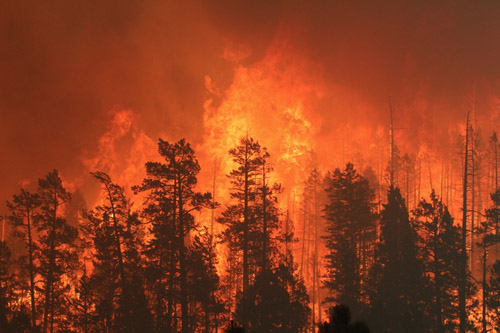
The following post is written by Jon Schwedler, communications manager for The Nature Conservancy’s Restoring America’s Forests program. For the past 14 years, Jon has worked on forest conservation efforts in Maryland, Virginia, Montana, New Mexico and California.
Was 2011 the year of mega-fire? The answer to that question depends where you live.
If you live in the American Southwest, 2011 indeed was the year of fire for you. Arizona, New Mexico and Texas all had record fires. The “mega-fires” in these states burned an area larger than New Jersey.
If the last seven years is any measure, these extreme fire events could become the new normal at a national scale. Indeed, the five biggest fire years in U.S. history have all come since 2004 (which includes 2011 — the 4th biggest year).

[Image: Only five years have more than eight million acres burned in the United States; all have occurred since 2004, including 2011.]
Why? And more importantly, what can be done?
First, in talking about mega-fires it is important to understand the context of what is “natural.” Prior to European colonization, wildfires sparked by lightning and Native Americans were common (Native Americans often used fire to encourage new plant growth as grazing areas for game). Fire experts tell us that more than two-thirds of North America’s forests and grasslands burned regularly — at least once every 30 years.
Thus, over many thousands of years, America’s outdoors evolved with low-intensity, recurrent wildfire. Indeed, many of our natural areas actually need fire just as much as they need water.
But today a perfect storm of events has pushed forest conditions past their tipping point, and created an uncharacteristic plague of mega-fires that burn too big, too hot and too fast.
First, Smokey Bear has done too good a job. A century of suppressing all fires has created an incredible backlog of overgrown brush in our forests. For example, one hundred years ago noted conservationist John Muir described being able to gallop a horse through the Sierra Nevada’s wide-open forests; today it would be difficult to even crawl through these same places.
Second, changing temperatures have simultaneously dried out forests and extended the living season for bugs that weaken our trees. When colder temperatures come later in the year, or don’t go low enough, these insects buy more time to eat, breed and damage forests.
The result today is a tinderbox of weakened forests about the size of Montana. The fires we’ve had since 2004 are a symptom of this cause, 100 years in the making.
But, ironically, part of the solution is more fire.
Not the kind of mega-fires we’ve seen this year, but rather much smaller controlled burns that are purposely planned, set and managed by the fire professionals in the U.S. Forest Service, state and local forest agencies and The Nature Conservancy. These “prescribed burns” remove overgrown brush in our forests, reducing the woody fuel that creates conditions for dangerous and costly accidental fires. The Nature Conservancy performed controlled burns on more than 130,000 acres of our own land last year.
Another thing we can do is actively thin some of our forests in overgrown areas so they can be healthier, which will provide benefits to people, water and wildlife.
A new federal program that invests in just these kinds of projects, the Collaborative Forest Landscape Restoration Program (CFLRP), has already shown great results in Arizona, California, Colorado, Florida, Idaho, Montana, New Mexico, Oregon and Washington. And besides lowering the risk of mega-fire, this program has also helped create or maintain more than 1,550 jobs.
Fortunately it looks like Capitol Hill is paying heed to this kind of success. In the 2012 budget Congress has fully invested in CFLRP, which means more communities will share its benefits.
On a personal level each of us can also pitch in, by being smarter about how and where we build our communities, and make our properties “firewise.”
While the smoke of 2011 has cleared, for many the mega-fires of 2011 will remain burned into memory. If we are able to fully embrace long-term investments in healthy forests, hopefully that’s where these mega-fires will stay.
[Image: 2011’s historic Wallow Fire in Arizona’s Apache Sitgreaves National Forest. Image credit: Jayson Coil, US Forest Service]